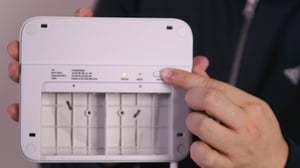This video will help you understand how to configure your Sensedge Mini, how to connect it to a network, and how to display your device on the Kaiterra Data Platform.
Timestamps:
0:00 - Introduction
0:22 - BEFORE WE BEGIN: Kaiterra Data Platform Account + Building Created
0:42 - Entering Configuration Mode
1:00 - Use the Kaiterra Configuration app to configure your device
Below is a text version of the video above! This is for those that prefer a laid-out text walkthrough or would like some clarity on some of the points made throughout the video.
Before we start, in addition to the device, you will also need:
- A smartphone that can connect to a WiFi network
- A Kaiterra Data Platform Account + The building already created in your account
- The latest version of our Kaiterra Configuration App

To start, you will need to turn the device on (or off and back on) in order to enable Configuration Mode.
This mode will last for 15 minutes.

On your smartphone, open up the Kaiterra Configuration app and select your building



Select "Add a device" followed by "Add Sensedge Mini" and follow the on-screen instructions to connect to the device.
For smartphone devices, you may receive a warning that the Wi-Fi signal from the Sensedge Mini has no Internet access. Make sure to "tap for options" and choose "stay connected", otherwise your phone will not properly connect!

Once connected, you will see the basic information about your device.
Press configure to proceed to the configuration steps.



From here, you will see a series of configuration steps. Fill in the sections that apply to your configuration.






Once you reach the end of the steps, make sure to verify your information is correct before pressing "Apply".

Once your device configuration is complete, you will be asked to assign a space to your device (aka. where is the device being installed?). This information can be pre-filled on the Kaiterra Data Platform. If not, you can choose "Add a floor" and "Add new space" to fill in the information.

Once you press "Save", your device configuration is complete!
If you have any problems with setting up, connecting, or configuring your Sensedge Mini, get in touch with us by submitting a support ticket!
